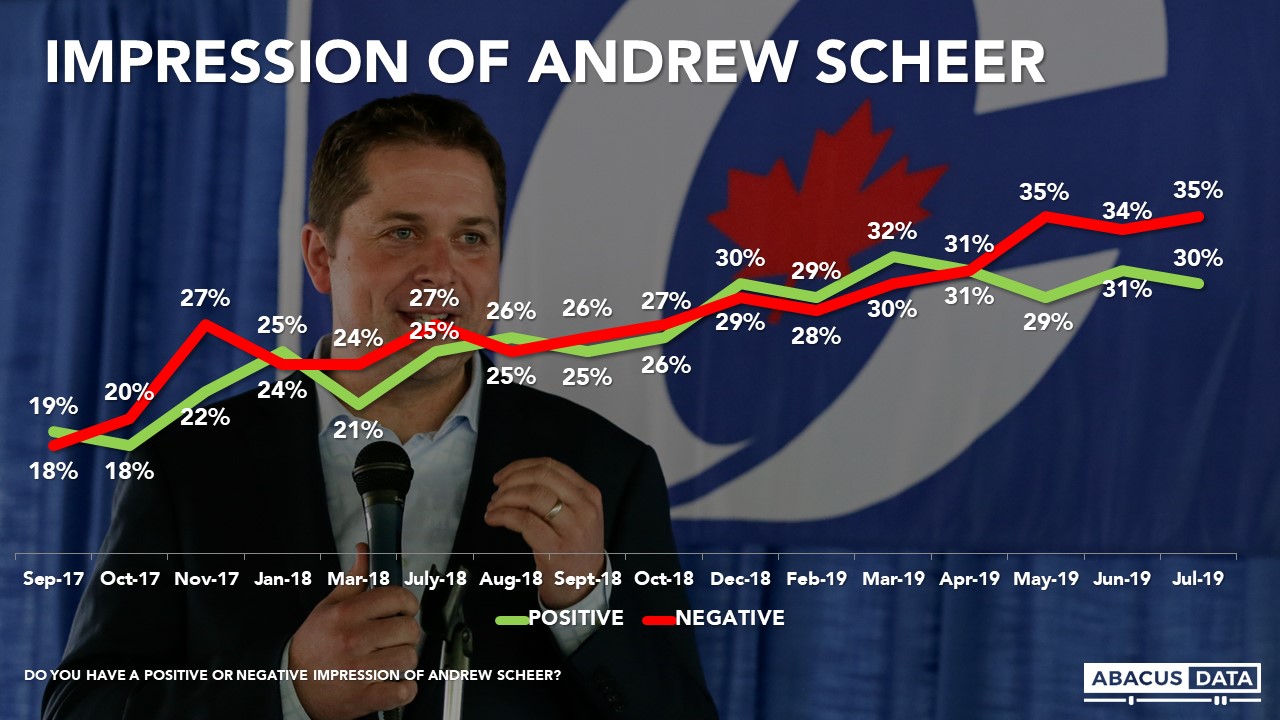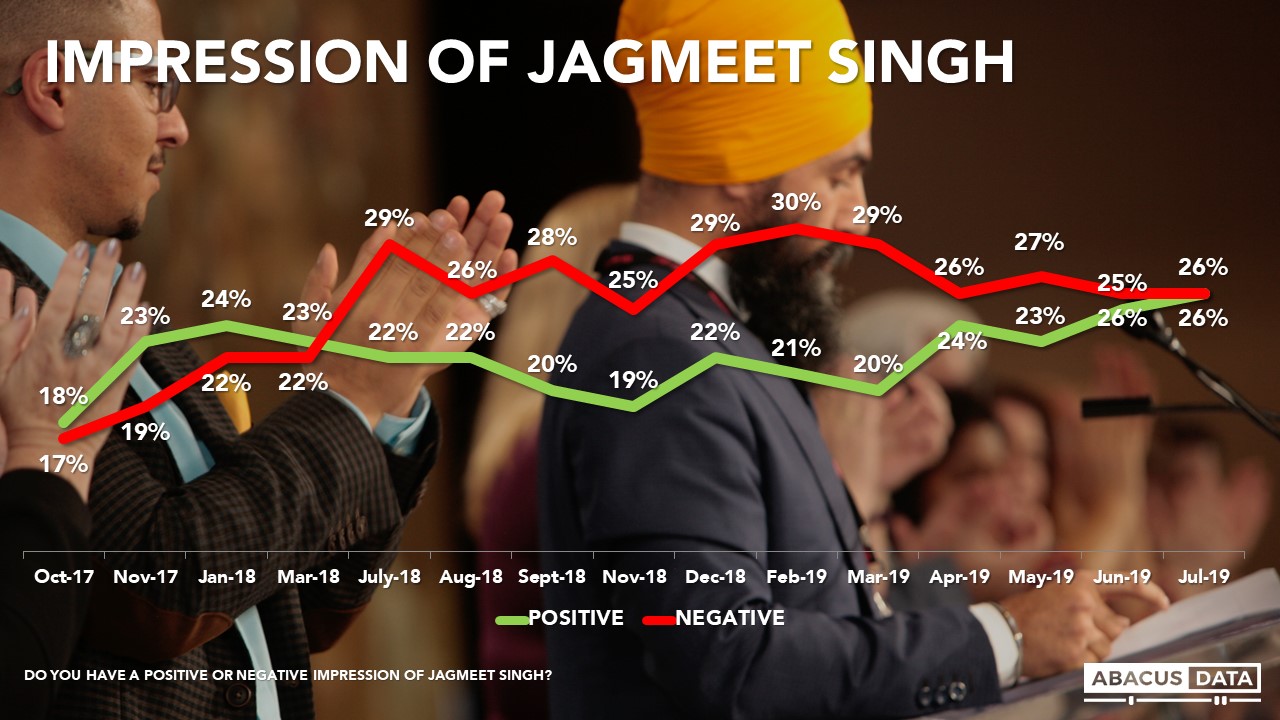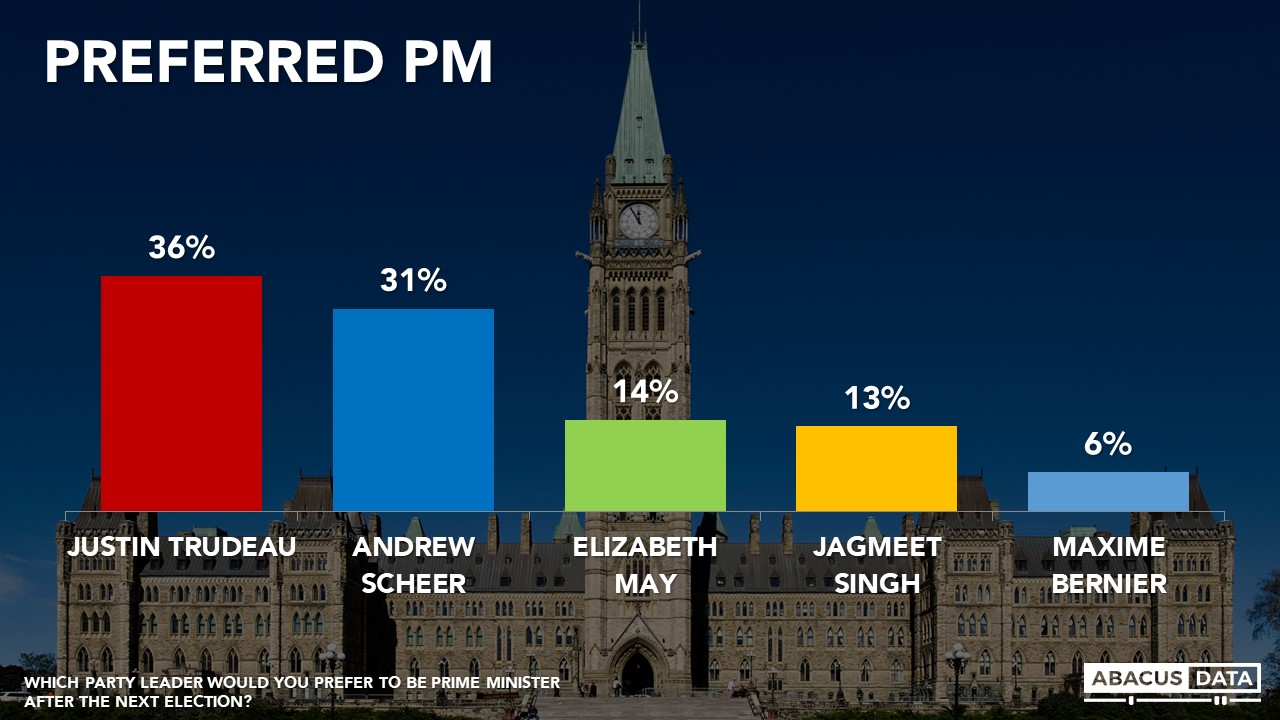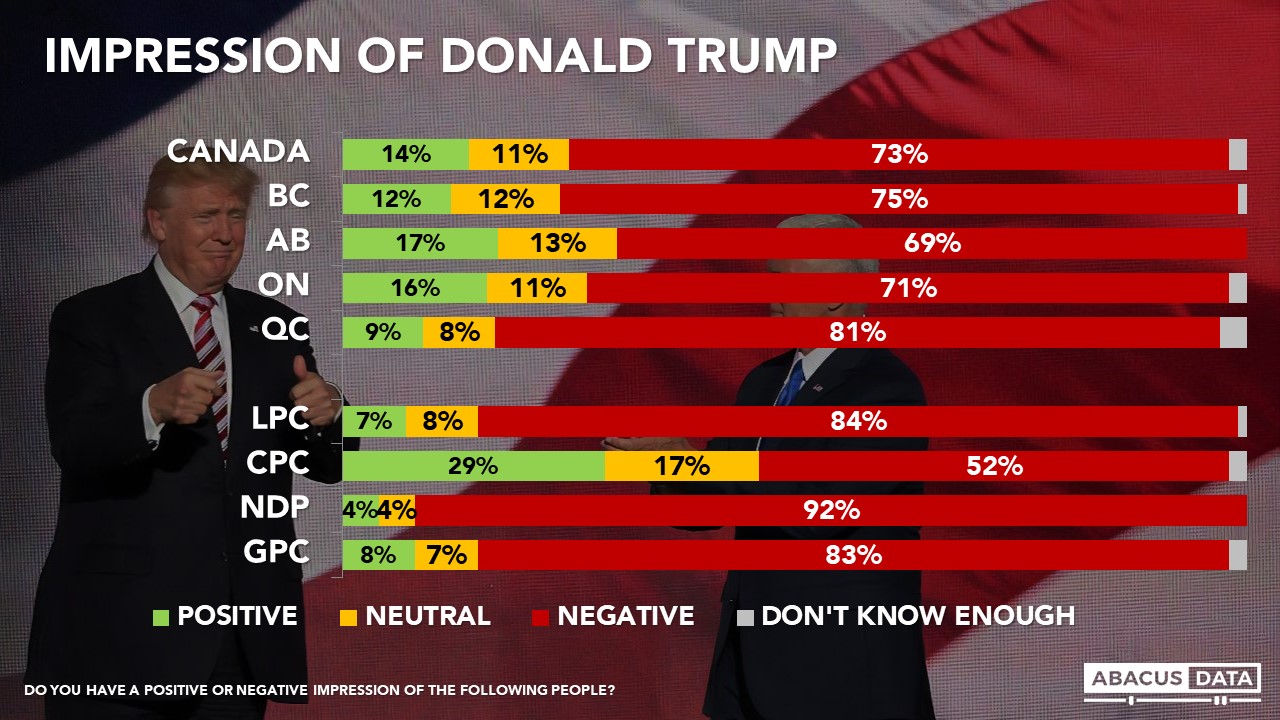Liberals and Conservatives deadlocked at 32%
July 22, 2019
This week we completed another national survey of 1,500 Canadian adults. With less than 100 days to go before Canadians select their next parliament, we updated our political tracking.
Here’s what we found:
LIBERALS AND CONSERVATIVES DEADLOCKED AT 32%
If an election was held at the time of the survey, the Liberals and Conservatives would each get 32% of committed voter support, followed by the NDP at 16%, the Greens at 11%, and the BQ at 4%. All these numbers are virtually unchanged since our last survey at the end of June.

Regionally, the Conservatives hold big leads in the Prairies (30 points in AB and 21 points in SK/MB) while the Liberals have comfortable leads in Quebec (17 points) and Atlantic Canada (9 points). Ontario and British Columbia both remain very competitive with the Liberals and Conservatives statistically tied.

The NDP finds itself without a region where its support is concentrated with about 17% to 19% in all regions save for Quebec where it trails in fifth place behind the Greens at only 8%. Green Party support is similarly spread out across the country with a higher concentration in BC (especially on Vancouver Island where the Greens are polling at 27% compared with 14% in the rest of the province).
Demographically, the Liberals lead by 4 among women while the Conservatives lead by 4 among men. Women are 7-points more likely to support the NDP than men. They are also 6-points more likely to support the Greens than men.

We also find some, but not substantial generational differences at this point in time. The Liberals have a small, 4-point lead among Millennials, the Conservatives and Liberals are tied among Gen X, while the Conservatives have a small 3-point lead among Baby Boomers. The NDP does better among younger generations than older ones.
The Liberals lead by 23 among those who self-identify on the left of the spectrum while the Conservatives lead by almost 50 among those on the right. Among those in the centre (representing about 50% of the electorate), the Liberals and Conservatives are basically tied with about 30% each.

ACCESSIBLE VOTER POOLS REMAIN PRETTY STABLE
Accessible voter pools for the Liberals (50%), Conservatives (48%) and NDP (44%) are largely unchanged from our June survey. The Green Party pool remains elevated at 40% but is 4 points lower than in May. In Quebec, 29% would consider voting for the BQ, down two since June.

TRUDEAU & SCHEER STEADY, SINGH’S NET APPROVAL IMPROVES
Today, 35% say they have a positive view of Mr. Trudeau and 46% negative, unchanged from June. For Mr. Scheer, 35% viewing him negatively compared with 30% positively. This is largely unchanged since June.


For Mr. Singh, we see 26% positive and 26% negative, a slight improvement in his numbers overall over the past few months, but largely unchanged since June. For Ms. May, we find 29% positive, 17% negative, a 4-point deep in positive impressions since May.


When we ask who respondents would prefer to be Prime Minister after the next election, Mr. Trudeau continues to lead Mr. Scheer. This too is largely unchanged from June.

HOW WILL PROVINCIAL PREMIERS IMPACT THE ELECTION?
There has been a lot of discussion about the impact provincial premiers may have on the federal vote coming out of the Council of the Federation meeting earlier this month. Going forward we will track impressions of four premiers – Ontario’s Doug Ford, Quebec’s Francois Legault, Alberta’s Jason Kenney, and BC’s John Horgan.
In our latest survey, Ontario Premier Doug Ford has by far the highest national profile and the most negative impressions. Over half of Canadians have a negative view of him compared to less than 1 in 5 who view him positively. In Ontario, 62% have a negative view compared with 23% who view him positively.

The other three premiers are less well known nationally with Jason Kenney the next most known (65% say they have an impression of him). 21% have a negative impression of Mr. Kenney while 14% view him positively. In Alberta, 41% view him positively compared with 33% negatively.
For Mr. Legault, his national profile isn’t that high (43% don’t know enough about him to have an impression) with about equal numbers viewing him positively and negatively. In Quebec, Mr. Legault is relatively popular with 49% having a positive impression compared with 22% who view him negatively.
For BC Premier John Horgan, his national profile is the smallest (half of Canadians don’t know enough about him to assess). He’s viewed fairly positively with 36% have a positive impression of him compared with 23% negative.

WHAT ABOUT TRUMP?
And then there’s US President Donald J. Trump. He is by far the most unpopular political leader we have tracked in a long time. Only 14% of Canadians have a positive impression of him compared with 73% who view him negatively. He’s least popular in Quebec (81% negative) and “most” popular in Alberta (17% positive) although even most Albertans don’t like him either (69% negative).

A majority of all Canadian party supporters have a negative view of Trump, including 84% of Liberal, 92% of NDP, 83% of Green, but just 52% of Conservative supporters.
WHO WILL WIN THE ELECTION?
As we get closer to the election, expectations become increasingly important. And while vote intention and impressions of the party leaders really haven’t changed over the past few weeks, the expected outcome of the election has.
Canadians are still more likely to think that the Conservatives will win the election (33%), but this expectation is down 3 points since June. 27% think the Liberals will win, up 2, while 7% think the NDP will win the election, down 2 since June. Almost a third (29%) think the election is still too close to call.

UPSHOT
According to Bruce Anderson: “This election year started with downward momentum for the Liberals and growth for the Conservatives. Both those patterns have arrested, and the race is especially tight in Ontario and BC. In Ontario, the impact of Doug Ford’s unpopular policies and style is a headwind for Andrew Scheer. In BC, the role of the Green Party is something of a spoiler for the Liberals right now. What happens with Green and NDP support levels may ultimately determine how this election turns out.”
According to David Coletto: “It’s pretty clear at this point that the 2019 election may start like the 2015 one: with little clarity and a very tight race. Structurally, the Liberals have an advantage in that they are leading in seat-rich areas and are competitive in more parts of the country. But the Conservatives benefit from a slightly more motivated voter base which if it holds, could be enough to win more votes than the Liberals.”
And in case you missed it, earlier this week we released a study of the top issues Canadians tell us will drive their vote this fall: https://abacusdata.ca/election-2019-is-a-battle-to-define-the-agenda/
METHODOLOGY
Our survey was conducted online with 1,500 Canadians aged 18 and over from July 12 to July 17, 2019. A random sample of panellists was invited to complete the survey from a set of partner panels based on the Lucid exchange platform. These partners are double opt-in survey panels, blended to manage out potential skews in the data from a single source.
The margin of error for a comparable probability-based random sample of the same size is +/- 2.6%, 19 times out of 20. The data were weighted according to census data to ensure that the sample matched Canada’s population according to age, gender, educational attainment, and region. Totals may not add up to 100 due to rounding.

ABOUT ABACUS DATA
We are the only research and strategy firm that helps organizations respond to the disruptive risks and opportunities in a world where demographics and technology are changing more quickly than ever.
We are an innovative, fast-growing public opinion and marketing research consultancy. We use the latest technology, sound science, and deep experience to generate top-flight research-based advice to our clients. We offer global research capacity with a strong focus on customer service, attention to detail and exceptional value.
Contact us with any questions.
Find out more about how we can help your organization by downloading our corporate profile and service offering.




